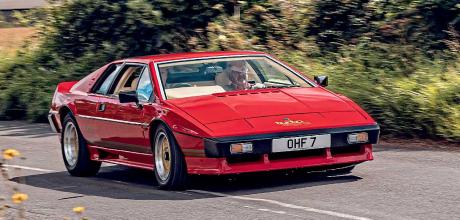1982 Lotus Turbo Esprit
Martin Cliffe developed the engine for the Lotus Turbo Esprit, yet he’d never owned one until recently. Today we both drive it, then compare notes on how it shapes up retrospectively.
Words NIGEL BOOTHMAN
Photography ALEX TAPLEY BLOWN
Turbo Esprit test and creator interview
Blown Away
We drive the Lotus Turbo Esprit recently bought by original engineer Martin Cliffe
PLUS The Turbo’s creators candidly recall its development rollercoaster
Engineer Martin Cliffe takes the wheel of the supercar he helped create
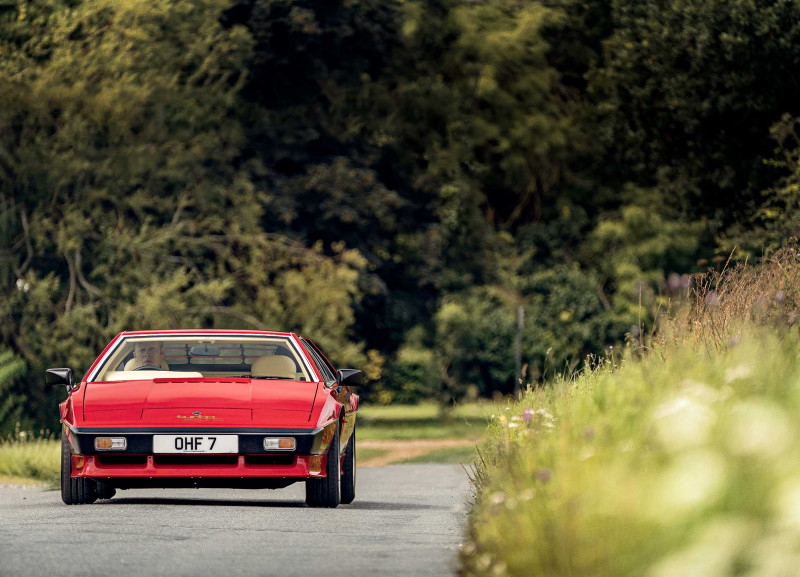
‘There’s still that unreal sensation of being dragged to the horizon by a bungee cord’
It’s almost 20 years since I drove a Turbo Esprit, and I remember it as a thrilling near-supercar that put many contemporaries in the shade. Driving former Lotus engineer Martin Cliffe’s car today, with him playing passenger, it feels older than I expect – but on my first drive myself and the car were in our twenties, and now, in our forties, we have aged a good deal.
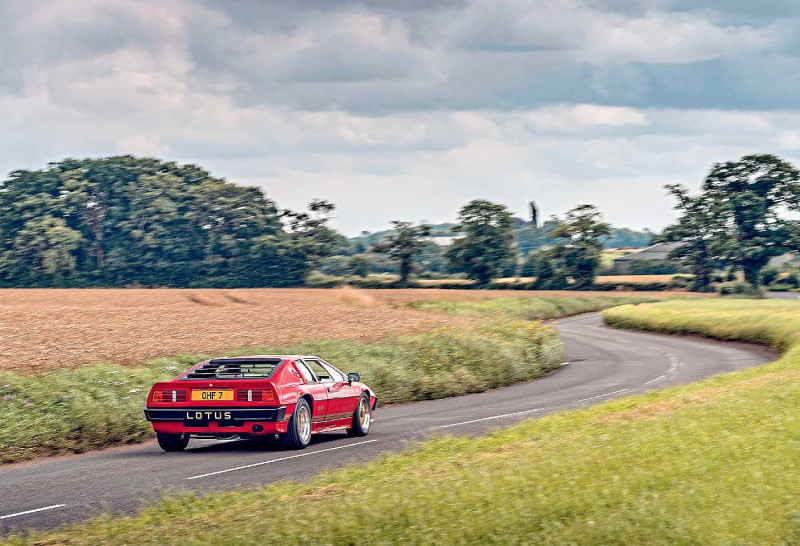
In the car’s case, this feeling is mainly down to the ergonomics inherited from the Series 1 and 2 Esprits. You lie down in a banana-shaped bucket seat, cocooned by the large central tunnel, the door and the dash, the roof bearing down on your bonce. Lotus’ then managing director, Mike Kimberley, lost out in a battle with Colin Chapman to make the Esprit comfortable for people of 6ft 5in (Mike’s own height), though it’s an improvement over the diminutive Europa. But sports cars and their interiors have grown enormously since then, making a greater contrast between the Esprit’s era and the present than I’d expected. The Dell’Orto carburettors require a bit of throttle at startup, like any other twin-choke Italian carbs. They’re fed from a sealed plenum chamber that in turn is fed by the turbocharger, but at low speeds on country lanes there’s little difference from a naturally-aspirated Esprit. The throttle likes gentle treatment for smooth progress while everything warms up; the steering is the same heavy, direct experience through the small wheel; and the engine is a gruff four-cylinder growl behind your head. The gear linkage, relying on a cable for the cross-gate action, asks you to concentrate on each change.
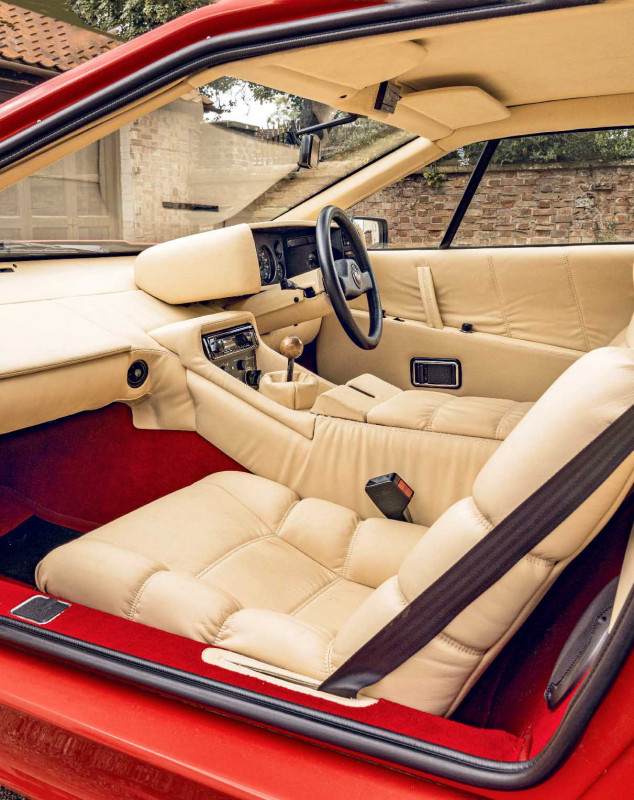
I turn onto a larger road, leave the village and escape what little traffic rural Norfolk has to offer. The engine is warming through, a slight cough and hesitation evaporates and an insistent surge of acceleration propels us forward. It’s not the lunge associated with other examples of early turbocharged cars – whip the horses, wait a couple of seconds and then hang on – it’s a more linear experience. There’s still that slightly unreal turbo sensation of being dragged to the horizon by a bungee cord, with acceleration breeding more acceleration, but the wildness of it has been ironed out. It’s only once you lift off the throttle and hear the whoosh and flutter behind your right ear that you’re certain about the presence of a turbo. It’s not the wastegate, but rather a surging of the compressor caused by the pressurised inlet charge arriving at closed throttle butterflies. Harmless but aurally distinctive.
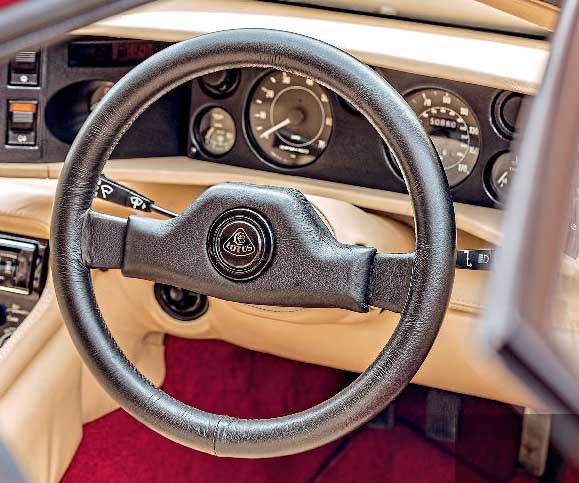
Now we’re motoring, and that turbocharger is not the only aspect of this car to show itself properly. The whole plot comes together, with high-geared steering letting you flow through bends at what you thought was a decent speed, but which soon seems pathetically far from the limit. There is some body roll, but very little by the standards of the time; probably just enough to permit the Esprit’s strangely accomplished ride quality. It’s firm, of course, but supple and well-insulated. You know you’ve driven over a bump, but you never feel the edge of the pothole, as you do in so many track-tuned sporting cars. In development, the Esprit was tested extensively on track at Hethel, but neither Chapman nor his team lost sight of where it would really be used – bumpy B-roads like this. Martin Cliffe recalls the first time Chapman drove the prototype Turbo, saying that after a lap or two on track, he turned out of the gates and onto the road – where it worked well, straight away.
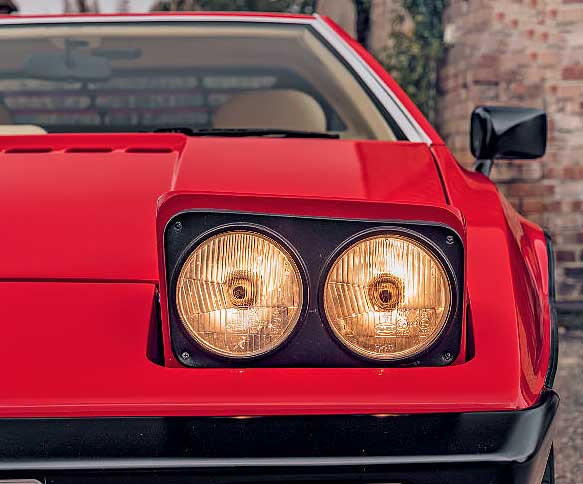
It still does, of course, with the brake pedal offering enough feel and power to instil total confidence. That can’t be said of the gearchange, which has improved as the ’box heats through, but is still obstructive rather than instinctive… room for improvement both with my technique and the linkage adjustment? The only other impediment in this car is the reflection in the windscreen caused by the dash top, trimmed in the same cream-coloured leather as the rest of the cabin. It’s like looking through a head-up display of a sandy beach, made more noticeable by the one spot that’s easy to see through – the dark area where the screen demisting vent reflects.
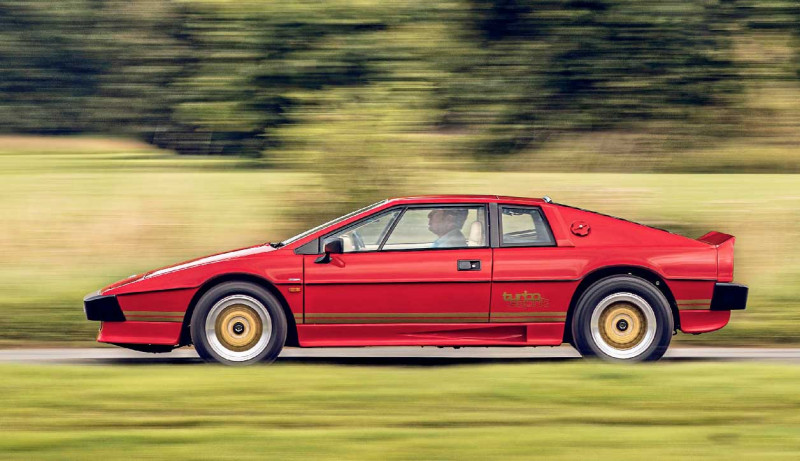
So we’re into the zone of forgiving an old car its foibles, though this is easily done when it has so much to offer on the open road. Dashing around the back lanes outside Norwich is home territory for any Lotus, but you soon get the feeling that this Turbo Esprit needs a bigger stage to show itself in the best light. Foot down in third gear and you’re propelled past the legal limit in no time, so you think of your licence and cruise quietly in fourth, hoping for a chance to drop a gear and overtake something… fifth remains largely untapped. How terrific it would be for a motorway dash to the Alps, ideally sans speed limits, and then some press-on driving over a pass or two. It’s fairly quiet, it has long legs and a broad torque curve, making it an effortless high-speed cruiser in a way that the Series 1 and 2 cars could never aspire to. The intentions behind turbocharging the Esprit had little to do with turning it into a plausible grand tourer, but that is a happy side-effect.

Martin Cliffe knows all about this, of course – he played a key role in the car’s development as principal engineer in the project to turbocharge the Lotus 907 engine. He did run a naturally-aspirated Esprit back in the early Eighties – ironically the Turbo Esprit prototype, sold to Martin by the factory without a driveline and then re-engined – but he’d never owned a production version. He bought this car last year after developing an itch to own an early Turbo – an itch that had been building for some time. ‘Four or five years ago, I found one for sale with a dealer in Kent that looked tremendous,’ says Martin, ‘but when I drove it I was so disappointed – it didn’t seem to have much performance and it wasn’t nice to drive. I told the dealer as much, and he said it was one of the better examples he’d had.’
After this discouragement, Martin wondered if the rose-tinted recall of four decades past had presented the Turbo Esprit as a better car than it really was, and he stopped searching. But last year he saw another for sale within minutes of his home. What was there to lose? It was being offered by a Lotus staff member on behalf of a customer, and it was waiting at the Classic Team Lotus premises across the road from the main site at Hethel.
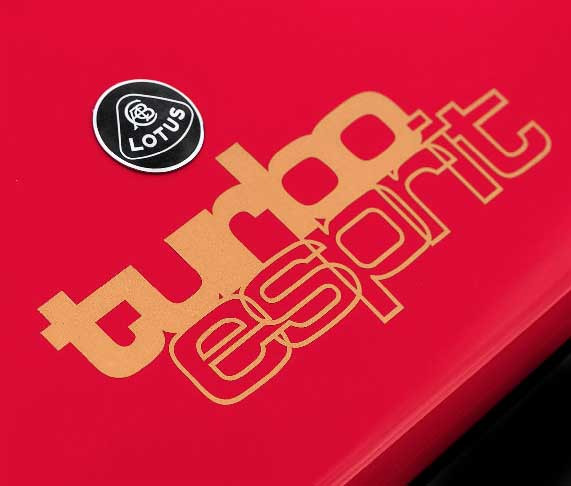
This car, OHF 7, was first registered on 6 September 1982 and would have been identical to the early versions on which Martin had responsibility for the powertrain. However, it’s enjoyed a great deal of expenditure in recent years and Martin says it’s been mechanically rebuilt in High Compression form, as introduced in 1987. ‘That means the compression ratio and boost pressure have been increased, adding 5bhp and 20lb ft of torque,’ he says, ‘but with larger carburettors on a longer inlet manifold. This was a retrograde step as far as quick throttle response went, although it was necessary to accommodate various add-ons that improved emissions.’
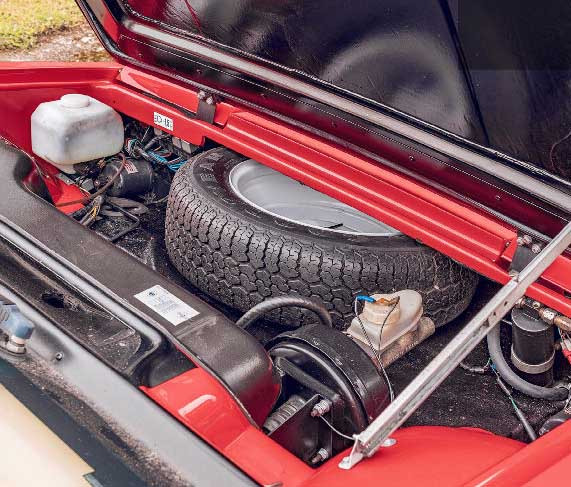
The example also benefits from the later swing-valve wastegate built into the turbine rather than the unreliable separate poppet-valve type (which Lotus was not allowed to buy from Garrett), while the cylinder liners are Nikasil-coated aluminium. The pistons are forged items from Mahle, not the original cast pistons that Martin had to redesign before they could survive the higher demands of a turbocharged engine.
‘In addition, it has an aftermarket stainless steel exhaust, the ignition has been upgraded to a mapped system and the brakes have been improved to four-piston calipers on the front with ventilated discs,’ says Martin. ‘Those at the rear are original, derived from the Lancia Gamma.’
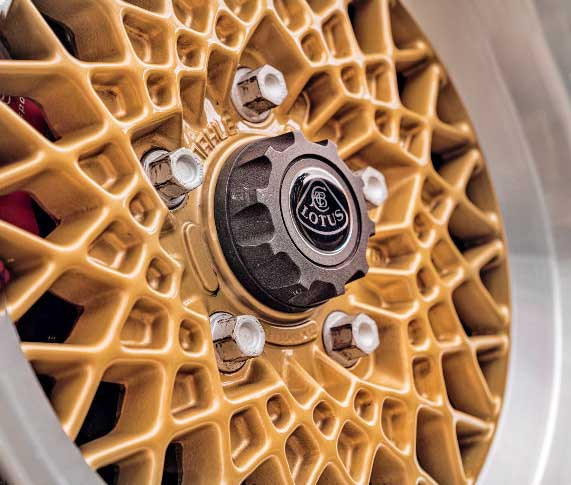
That explains the car’s stopping power, then. The difference between 1982-vintage and 1987-vintage performance might show up more on paper than in person, because it’s the whole Turbo Esprit experience that’s distinctive, not simply the straight-line urge. And in this case, the car’s fantastic cosmetic condition matched by the drive, or very nearly. ‘It pops a little on the over-run and the choke can stick on, but this one was so much better than the other,’ is Martin’s overall appraisal .In fact, since our meeting, Martin has discovered some surprising things: US Federal-spec carburettor jetting, an un-blanked throttle-edge port, incorrect float heights, too much fuel pressure and a throttle stop fouling on the carb’s casting. With everything back to European specification, he reports even more performance and no misbehaviour.
Purchase of this car closed a loop that opened rather a long time ago. Martin’s own story with Lotus began in 1978, during a visit to the Motor Show at the NEC. He and his wife Elizabeth were looking around the show separately, when she reached the Lotus stand and saw Colin Chapman leaning on a rail, looking bored. ‘I decided to go and talk to him,’ says Elizabeth, ‘I said I’d like to shake the hand of one of the country’s great engineers. We got chatting and I told him about Martin, and what he did.’ Martin was working as a Sales Engineer for Holset, one of a very few turbo specialists established at that time. Chapman’s ears pricked up and soon afterwards, Elizabeth met Martin for lunch and told him he was due at the Lotus stand at 2pm for an impromptu job interview. Once Martin had recovered from the surprise, he went along and met not only Chapman, but also Mike Kimberley, engineering director Tony Rudd and Fred Bushell, the financial director.
‘There were various interviews back and forth after that, but in the end, I quite happily took a pay cut to work for Lotus at the beginning of 1979,’ he recalls. ‘I still have the letter Lotus sent, stating that “no-one works at Lotus for fame, fortune or security”.’ That was true, as Martin soon discovered, recalling endless allnighters and not much in the way of time off for holidays, an environment he generously describes as ‘character forming’.
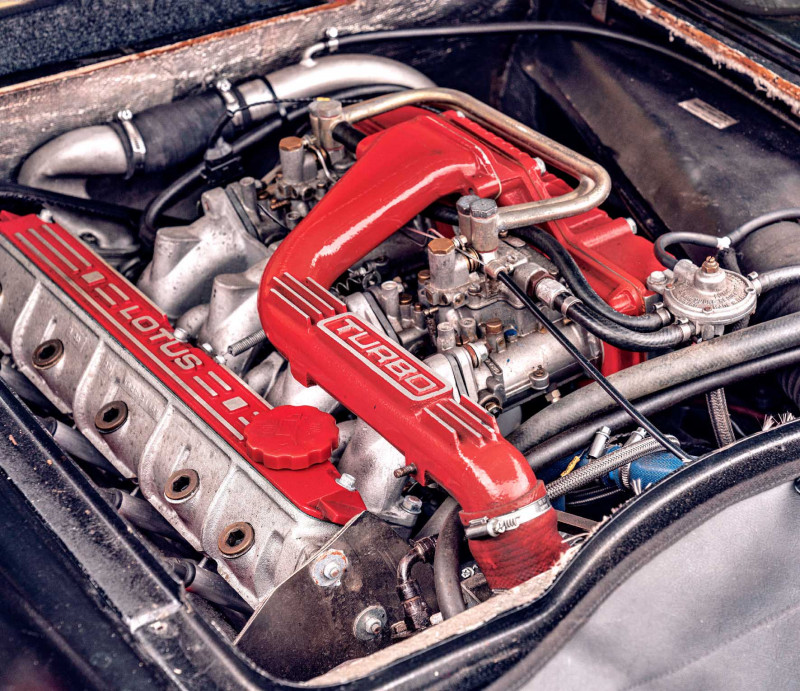
The car Martin was attempting to transform was already almost eight years old at this point, if you go back to the first concept created by Giorgetto Giugiaro. That one, the star of the Turin Motor Show in 1972, had been created in six months flat from the first lunch with Giugiaro to the opening of the show. Mike Kimberley had supplied a lengthened, widened Europa Twin-Cam chassis for ItalDesign to work with and the dramatic results exceeded everyone’s expectations. But as has since been well documented, the step from idea to show car was far quicker than that from show car to production. Turning Giugiaro’s pure shape into something Lotus could actually build, and which would be safe and sufficiently practical, took until the autumn of 1975. And for some of that time, there was an intention to launch the car with a choice of four-cylinder and V8 engines.
A lack of funds meant that ultimately only the four-cylinder, 2.0-litre version arrived. For a car aimed at a niche between Porsche and Ferrari, this left the Esprit a little short of firepower, especially in the USA where strict Federal emissions standards pruned it of 20bhp. And that, in turn, led Colin Chapman and Mike Kimberley to seek cost-effective ways to improve things. The story of the Turbo Esprit project, and Martin’s key role in engineering its 2.2-litre turbocharged engine, is covered in detail in our interview with Martin, Mike Kimberley and powertrains manager Graham Atkin that starts on.
The first Turbos, unforgettable in their special Essex Petroleum livery, reached customers from late summer, 1980. By the middle of 1982, concerned at the many challenges facing Lotus – an ill-fated tilt at making boats, a struggling Formula 1 team, worrying noises from the banks – and tiring of friction with Rudd, Martin left to found Omicron Engineering. This was initially a consultancy working on turbo conversions, four-wheel drive and other projects, but it slowly evolved to become the country’s best-known classic Lancia specialist. How does Martin assess the Turbo Esprit now? Is it possible to apply hindsight, or a clear vision un-tinted by 40 years of memories?
‘When it was new, I hadn’t driven anything better, faster or more satisfying. Then, as the years went by, I was lucky enough to drive all sorts of faster and more advanced cars, which clouds your judgement. But I think the Turbo Esprit must be viewed alongside its contemporaries, and if you look at almost any magazine article from the time comparing the Turbo Esprit with rivals from Porsche, Ferrari, Maserati and so on, it receives high praise. Which I think it deserves… it’s a very exciting car.’
After a day in the driving seat, I know exactly why I remembered the Turbo Esprit so fondly and forgot its shortcomings. It’s because you get used to the constrictions in a few short miles and revel in the combination of torque, power and chassis dynamics that finally showed off the Esprit to its full potential. Then, when you clamber out, you’re dazzled all over again by the car’s stunning visual presence. On paper, the turbo put the car absolutely on a par with the 1980 Porsche 911SC – same 0-60mph time, same top speed – and they’re more similar in some ways than you might think. Both have enough midrange torque to be relaxing, yet both need revs to feel really quick, with the Esprit’s power delivery more like a sporting engine coming ‘on cam’ than a laggy first-gen turbo. To be involved in the creation of such a machine was both a trial and a privilege for Martin Cliffe, and perhaps the only surprise in his ownership of this car is that it took 40 years to happen. Who says you should never go back?
TECHNICAL DATA 1982 Lotus Turbo Esprit (as standard)
- Engine 2174cc inline four, dohc, two Dell’Orto twin-choke side-draught carburettors
- Max Power 210bhp @ 6000rpm,
- Max Torque 200lb ft @ 4000rpm
- Transmission Five-speed manual, rear-wheel drive
- Suspension Front: independent by double wishbones, coil springs and Armstrong telescopic dampers. Rear: independent by lower
- wishbones, unequal length transverse links with radius arms, coil springs and Armstrong telescopic dampers
- Brakes servo-assisted discs, front and rear
- Weight 1204kg (2653lb)
- Performance
- Top speed 149mph
- 0-60mph: 6.1sec
- Fuel consumption 21 mpg
- Cost new £16,982 (at launch)
- Classic Cars Price Guide £13,000-£35,000
OWNING A TURBO ESPRIT
‘The turbocharged engines are durable, providing common sense and mechanical sympathy are used,’ says Martin Cliffe.
‘However, the early wastegate used before the 1987 HC variant can stick shut, leading to excess boost pressure and wrecking the engine – you have to keep your eye on that boost gauge.
‘Many cars do not handle the way they should and this is largely down to incorrectly set suspension geometry and poor quality aftermarket dampers. A huge amount of work went into calibrating the valving for the original Armstrongs. Lotus later did an exercise with Bilstein to establish specifications that were equal or better.’
Budget £500 for the ‘A’ service (oil, filter and various checks); £750 for a ‘B’ service that adds plugs, air filter and extra checks; £1700 for the ‘C’ service that adds cambelt, fuel filter, coolant and gear oil. ‘I think the main message is not to cut corners,’ says Martin. ‘Use qualified mechanics, genuine Lotus parts and follow the workshop manual. Don’t expect a Lotus to be cheap to run.’
Note lack of body roll — yet ride is supple and controlled. Luggage space exists behind engine, not in the nose That’s ‘Turbo Esprit’, not ‘Esprit Turbo’ BBS Mahle alloys became a badge of honour in the Eighties. Nest of pale hide is inviting, but dash unit has since been recovered in black to remove relfections. While these ribbonlike spools have always been Lotus stomping ground… ...the Turbo Esprit’s talents make it proper grand tourer, if required.
‘Back lanes outside Norwich are home territory for any Lotus, but you soon get the feeling that it needs a bigger stage’
Martin recalls the Turbo’s stressful but successful gestation Giugiaro’s artful lines still apparent under Turbo’s body kit. Your connection to the road — not quite telepathic, but not far off.
Turbo installation is simple in principle but cutting-edge details killed most throttle lag.


